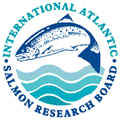SALSEA-Track
SALSEA-Track
In 2012 / 2013 the Board reviewed its research priorities. The Board noted that genetic stock identification and other advances in the field of genetics, migration modelling, tracking and studies of the diet of salmon at sea all have considerable implications for management and there have been advances in all these areas of research under the SALSEA Programme. The Board decided that a particular focus should be given to studies to partition mortality of salmon among the phases of the marine migration and it established a Telemetry Sub-Group to advise on the development of an international programme of research.
As a first step in developing an International Telemetry Programme, the Board hosted a Workshop. This Workshop had developed outline proposals for telemetry studies which were then endorsed by the Board:
- Drifters and BioProbes: Options for detecting acoustically tagged fish in large geographic areas (NAC and/or NEAC);
- New Receiver Lines/Arrays/Grids (NAC);
- Platforms of Opportunity in the NAC area: Stationary Platforms of Opportunity Receiver Exchange (SPORE);
- NAC kelt satellite tagging;
- Generic Index River Sites in the NEAC area;
- Malin Head to Islay Receiver Array (NEAC);
- North Sea Loose Array (NEAC);
- West-coast Scottish arrays (NEAC);
- Studies of migration along the European shelf edge and into the Norwegian Sea using drifters/AUVs etc (NEAC);
- NEAC kelt satellite tagging;
- Sub-adult satellite tagging at Faroes; and
- Adult satellite/acoustic tagging at Greenland.
In 2014, the Board endorsed the need for an international acoustic tracking programme and adopted a Resolution (ICR(14)10) encouraging Parties to continue the development of local collaborative telemetry projects, encouraging the development of large international collaborative projects building on local efforts and encouraging Parties to make efforts to identify funding sources.
The Board recognised the high value of the SALSEA brand and the strong impact of NASCO as the international forum for consultation and cooperation on wild Atlantic salmon. The Board reaffirmed its commitment to an international telemetry project under the SALSEA brand, named ‘SALSEA-Track’. Specifically, the Board agreed to support SALSEA-Track as a continuing commitment to understanding the factors affecting mortality of salmon at sea, to make funds available to prepare a vision statement for SALSEA-Track and to advance existing initiatives towards an integrated collaborative telemetry programme.
In 2020, the Board convened a Working Group to Review the SALSEA-Track Programme and the Inventory of Research Relating to Salmon Mortality in the Sea. The Working Group recommended that the SALSEA-Track Programme, in its current form, should be closed, given that several of the projects had not borne fruit after six years and that funding had not been forthcoming in many instances. The Board agreed to this recommendation. The intention is to find a single, basin-scale project to replace SALSEA-Track with the following attributes: be problem focused with a clearly defined internationally relevant question, which is not solely developed based on the newest technology available; have clear SMART objectives; have clear timelines; have a clear budget; and have an identified owner / co-ordinator. Additionally, it should address issues such as: data gaps / climate change / commonalities across the jurisdictions / mechanisms for supporting new technologies.
Publications
- Report of the Working Group to Review the SALSEA-Track Programme and the Inventory of Research Relating to Salmon Mortality in the Sea (ICR(20)07);
- SALSEA – Track: Innovative research to solve the mystery of Atlantic salmon mortality at sea (2016);
- Report of NASCO’s International Atlantic Salmon Research Board’s Telemetry Workshop (ICR(15)3) ;
- Resolution of the International Atlantic Salmon Research Board (IASRB) on Research on Salmon at Sea (ICR(14)10);
- Report of the SAG Sub-Group on Telemetry (SAG(14)4);
- Report of the Meeting of the Sub-Group on the Future Direction of Research on Marine Survival of Salmon (SAG(13)2).
